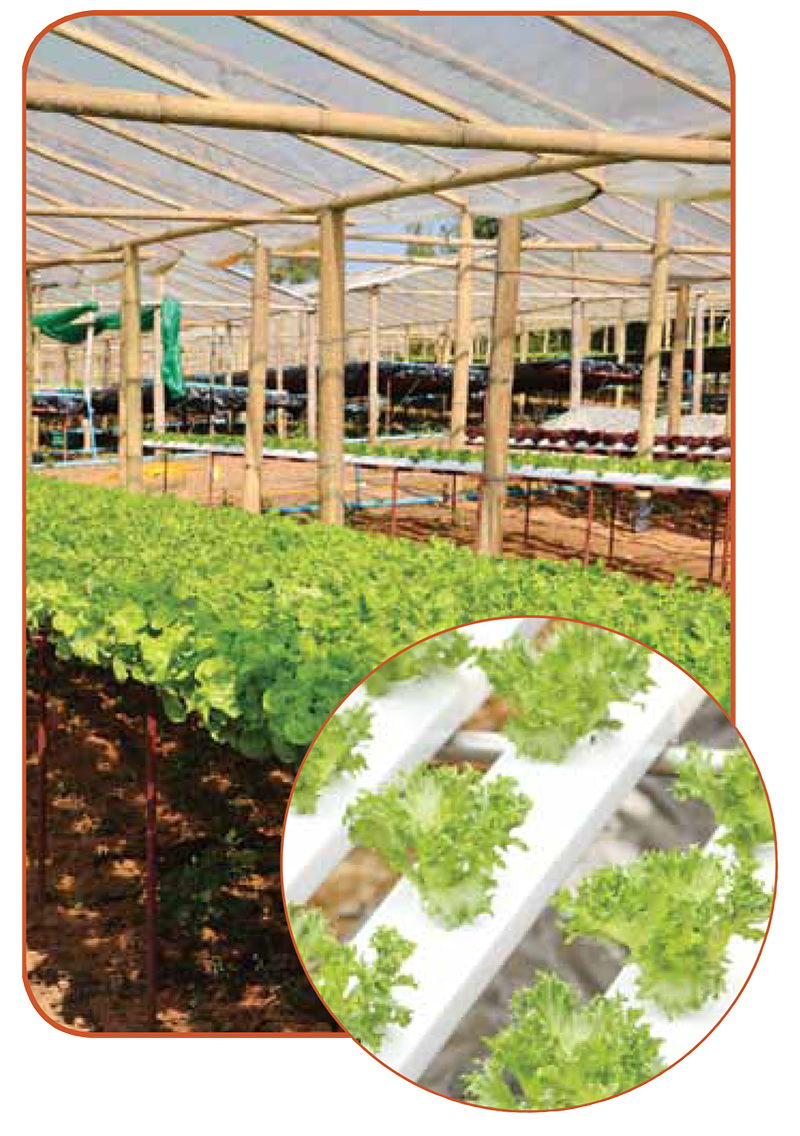 Relevancy and Engagement
dc.agclassroom.org
Relevancy and Engagement
dc.agclassroom.org
What? No Soil?
Grade Level
Purpose
After learning the five basic requirements of plant growth, students discuss terms related to hydroponics. Students then build and maintain hydroponic units from soda bottles. Grades 6-8
Estimated Time
Materials Needed
- Teacher Material– New Terms and Plant Nutrients (one per teacher)
- Handout A – Static Hydroponic Activities (one per student)
- Assessment A – What? No Soil? (one per student)
- Several two-liter plastic soda bottles
- Large piece of one-inch thick styrofoam
- Marking pen and labels
- Distilled water
- Electronic electrical conductivity (EC) meter
- Hydroponic nutrient solution (Hydro-Sol)
- Wisconsin Fast Plant with roots or other rooted plant start
- Calcium nitrate
- Electronic pH tester
- Aquarium air pump
- Aquarium air pump line/tubing
- Razor or utility knife
- Short blade scissors
- Cotton balls
- Optional: PVC pipe, PVC cement and PVC pipe cap
Many of the supplies required for this lab can be purchased from Carolina Biological Supply Company (2700 York Road Burlington, NC 27215; 800-334-5551)
Vocabulary
aerate: to supply soil with air
anchorage: plant roots and stems becoming stabilized or “anchored” in their growing media. In hydroponics systems, devices or systems must anchor plants in the absence of soil
geoponics: growing plants in the soil found on the earth’s surface; geoponics can be looked as the “opposite” of hydroponics
hydroponics: the method of cultivating plants using a mineral nutrient solution in a water solvent without the use of soil
nutrient: a substance that provides nourishment essential for growth and the maintenance of life
nutrient solution: liquid fertilizer used in hydroponics
primary nutrients: the mineral nutrients plants need in the greatest quantities: Nitrogen (N), Phosphorus (P), and Potassium (K)
respiration: the process through which a plant exchanges oxygen and carbon dioxide with its environment
transpiration: the process by which plants release water vapor back into the atmosphere through their stomata
Did You Know?
- Iceburg lettuce got its name from the fact that California growers started shipping it covered with heaps of crushed ice in the 1920s. It had previously been called Crisphead lettuce.
Background Agricultural Connections
The floating gardens of the Aztecs of Mexico and the hieroglyphics of ancient Egypt describe growing plants in water. Some even speculate that the hanging gardens of Babylon were in fact hydroponic. (Resh) Although we have ancient accounts, John Woodward is the first person accredited for growing plants in liquid medium (1699). In the 1860’s, German scientists Sachs and Knop organized the first liquid solution into a research science technique. William Gericke of University of California Berkeley was the first hydroponic user to produce crops with the method. (Bugbee/Hershey)
 The word “Hydroponics” refers to two Greek words, “water” and “working.” It is defined as the science of growing plants without soil.
The word “Hydroponics” refers to two Greek words, “water” and “working.” It is defined as the science of growing plants without soil.
In order for hydroponics to provide for the five basic needs of plants which are air, nutrients, water, light, and anchorage, some changes need to be made from traditional crop production. An aquarium pump provides the oxygen in a static hydroponic culture. The method of aerating the roots is not as important as the movement of the water over them. Nutrients are provided by a nutrient solution added to the jar. It must be checked every few days to maintain optimum pH levels. Water is provided along with the nutrient solution. Light is provided by the sun or artificial light. Anchorage is provided by a sponge or other material holding the plant in suspension above the nutrient solution.
Nutrients are essential to plant growth because they provide a constant source of food and energy. Without nutrients, the plant will not complete its life cycle in a normal manner. With prolonged deficiency, the plant will not survive. The primary nutrients involved in plant growth are nitrogen (N), phosphorus (P), and potassium (K).
The effects of these nutrients can be visually observed under many conditions:
Nitrogen (N)
- Optimum: Plants with the optimum amount of N are dark green and high in protein content.
- Deficient: Nitrogen deficiency is detected by a light green color. The lower leaves turn yellow and brown as they dry up. The plant is stunted, making the stem short and slender.
- Excess: Too much N will cause the plant to become very leafy. Flowering will be delayed.
Phosphorus (P)
- Optimum: P stimulates root formation and growth, provides plants with a healthy start, and stimulates flowering and seed development.
- Deficient: Phosphorus is needed for growth and flowering. If P is not provided, the plant grows slower and delays flower and pod development. The leaves in a P deprived plant are dark green with purple or red appearing along the veins. The lower leaves turn yellow and brown as they dry up. The plant stem becomes short and slender.
Potassium (K)
- Optimum: At optimum levels, K increases vigor and disease resistance. It also is important for the formation of starches, sugars, and translocated sugars.
- Deficient: Chlorotic (yellowing) leaves result from K deficiency. Necrotic (tissue death) spots between the veins, margins, or leaf tips appear. The plant stem becomes slender.
Information about the NPK effects is provided by the Wisconsin Fast Plants Program, University of Wisconsin, Department of Plant Pathology. Investigating Plant Physiology. Copyright 1989. Carolina Biological Supply Company.
The students will construct and monitor their own hydroponic system by following the instructor’s directions and prompting. Form groups of two or three students for this project.
Objectives
- Describe the five requirements that plants need to survive.
- Explain the three primary nutrients (macro elements) required by all plants.
- Define hydroponics.
- Construct and monitor a hydroponic system.
If desired, have a volunteer complete steps 5 and 6 of Part 1 on Handout A.
Engage
- Ask students to make a list of things plants need to grow. After they finish, discuss answers as a class.
- Talk about the five main growth requirements: air, nutrients, water, light, and anchorage. Next ask students if plants must be planted in soil to obtain these requirements.
- Explain that plants grown in a hydroponic system do not use soil and their nutritional needs are still met.
Explore and Explain
- Discuss the vocabulary words found on Teacher Material A- New Terms and Plant Nutrients. Also, discuss the nutrients required by plants to grow to maturity found on page 2. Discuss what happens when too little or too much of the nutrient is present.
- Assist students in creating and maintaining a hydroponic system made from soda bottles. Provide students with a copy of Handout A-Static Hydroponic Activities and the materials needed to complete the project.
Hydroponic System With a Soda Bottle:
- Obtain one plastic two-liter soda bottle.
- Fill the bottle with hot water to soften the glue on the label. Swish the water around to soften all the glue. Remove label. You may also use a hair dryer/blower to remove the labels.
- Mark the bottle at 23 cm from the base with a felt tip marker. Draw a line completely around the bottle.
- Use a razor or utility knife to start the cut and short-blade scissors to complete it.
- Place the cut soda bottle cut side down on the styrofoam block. Draw a line around the soda bottle on the styrofoam.
- Cut around the circle drawn on the styrofoam with a sharp knife. To get an even finish on the edges of the styrofoam, rub an extra piece of styrofoam against the rough edges of the styrofoam.
- Cut holes for the plants with scissors or poke a pencil through the styrofoam. If needed, surround the plant stems with cotton from cotton balls to help the plant stems stay in place in the holes.
- Make a hole in the styrofoam for the aquarium tube coming from the aquarium pump. The line should be extended through the hole and into the nutrient solution.
- Label your hydroponic system with your name, group number, and the date. Use a label and marking pen.
- Insert the styrofoam round into the soda bottle. Another soda bottle may serve as a humidity dome if desired.
 Formative Review:
Formative Review:
As a class, discuss the following questions:
- What is hydroponics? How is it different than geoponics (growing of plants in soil-based media)?
- Describe why plants need phosphorus to survive. What will happen if the plant has too much phosphorus?
- Explain why plants need nitrogen. What will happen if it has too much nitrogen? Too little?
- What are the five main needs of plants to survive? Explain what will happen if one of those needs is missing.
- After constructing your own hydroponic system, what do you see as a potential for hydroponics in the future? Can hydroponics feed the world? Is it a good way to produce food?
- Why does the plant need air from the aquarium pump? What will happen if the aquarium pump is taken out?
- What are some of the benefits of having a hydroponic system? What are some downfalls?
Elaborate
-
Test pH using hydroponic growing systems. Three different solutions will be needed: acidic, basic, and neutral with pH numbers of 4, 6, and 8. Acidic solutions can be obtained by adding sulfuric acid or vinegar to the nutrient solution. Basic solutions with a higher pH can be obtained by adding potassium hydroxide solution or baking soda to the nutrient solution. pH can be tested with a pocket, glass-electrode pH meter, or pH paper. The plants should be grown in three separate containers. Each container will have a different pH number. All other factors should remain constant. Record data and determine which solution is most tolerable to plant growth. Compare hydroponics and geoponics (growing plants in soil) by using the same plants and containers. Soda bottles will hold both mediums. Take care to assure that each plant starts under all the same conditions with exception to the growing medium. Plant one set of plants in the soil and one set in the hydroponic system. Monitor their growth and compare. (Bugbee/Hershey)
Evaluate
After conducting these activities, review and summarize the following agricultural literacy concepts:
- As world populations increase, the demand (or need) to grow our food also increases. Fertile soil and adequate growing climates are valuable. Hydroponics is a method of food production that farmers can use to produce food without the use of soil.
- A knowledge of biological principles (such as photosynthesis) is required for the successful application of a hydroponic growing system.
- Hydroponics is an example of science and technology being used in agriculture, the production of our food and other necessities.
Sources
Adapted from Technology, Life and Careers Agricultural Science and Technology Instructional Guide, project of the Utah State Office of Education. Protect Director Richard M Joerger, PhD., developed and written by Brenda Mager and Kari Osterhout, 1995.
Bugbee, Bruce and Gus Koerner. Teaching Hydroponic Science. “Inexpensive Hydroponic Teaching Methods” by David R. Hershey. (27-33)
Hershey, David R. “Solution Culture Hydroponics: History and Inexpensive Equipment.” The American Biology Teacher, Volume 56, No. 2, Feb 94 (111-118).